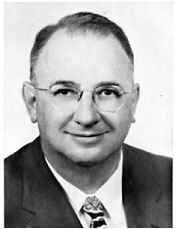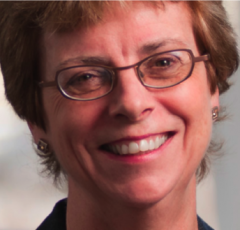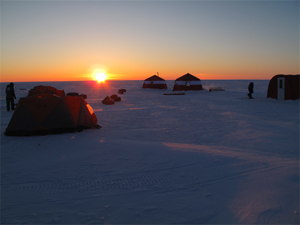by J. Marshall Shepherd, AMS President. Reprinted from The Mind of J. Marsh.
I had no intentions of writing anything about the Anniversary of my Alpha Phi Alpha fraternity brother Dr. Martin Luther King’s historic “Dream Speech” today. But as I sit here in the Tate Center of the University of Georgia eating breakfast and responding to emails from the Executive Director of the American Meteorological Society, a flood of realization came over me. Dr. King’s Dream is tangible for me and my career path.
King stated in 1963:
“I have a dream that one day little black boys and girls will be holding hands with little white boys and girls.”
I am one of those little black boys. I grew up in a small town north of Atlanta called Canton, Georgia. It is home and I cherish it. Yes, it had (and has) as any place does, pockets of hate and narrow thinking, but my experiences reflected the aforementioned quote. I went to school with, played S.W.A.T with, played sports with, and interacted with white and black kids. I eventually went on to be the first African American Valedictorian at Cherokee High School. I don’t make this point to brag. I make the point because it presents a dilemma in how I view it. On one hand, I feel proud to have achieved a goal and hopefully inspired someone else to strive to achieve academically. On the other hand, over 25 years later, I may still be the only person that looks like me to have given that speech. Indeed, times have changed but there is still room for me to continue to dream for my kids or for cousins that may aspire to similar goals at Cherokee High School.
But, I want to reflect on my personal career trajectory as a projection of King’s Dream forward.
I was blessed to be the first (and only) African American to receive a PhD in meteorology from Florida State University. This presents the same aforementioned dilemma. It’s too far past 1963 for these types of “firsts.” After a successful career at NASA, I returned to my home state of Georgia and am now the Director of the Atmospheric Sciences Program and the Athletic Association Professor of Geography and Atmospheric Sciences at the University of Georgia. Only 2 years before Dr. King delivered his “Dream Speech,” the University of Georgia was integrated and allowed black students, and now I am teaching, advising and mentoring students of all races.
Another significant milestone and blessing came last year when my peers, the members of the American Meteorological Society (AMS, www.ametsoc.org), the largest and oldest professional society in my field, elected me to serve as President. To serve as the President of one of the more influential science organizations in this country is a privilege and honor. So back to the email I mentioned earlier from Dr. Keith Seitter, AMS Executive Director. I emailed Keith to inquire how many members of the AMS would have looked like me in 1963, the time of the “Dream” speech. I guessed less than 10. Keith’s reply:
“Other than (Charlie) Anderson, I can only think of Warren Washington (not sure when he might have joined but probably close to then), and maybe June Bacon-Bercy (though she may have come on the scene closer to 1970), So, yes, almost surely less than 10, but probably not zero.”
These numbers are not a reflection of the AMS, it is more of reflection of the times. However, in 2013, a relatively : ) young African American that has loved weather since 6th grade presides over this esteemed organization with contributions from all races, genders, and cultures. I am the 2nd African American to serve as AMS President. My mentor and recent National Medal of Science recipient, Dr. Warren Washington (https://www2.ucar.edu/atmosnews/news/2890/warren-washington-receives-national-medal-science), was the first.
I owe many aspects of my career to the AMS and Warren Washington. I received one of the first AMS Industry Fellowships, have been afforded opportunities to lead and inspire within the organization, and have experienced the scholarly community of a first-class organization. Warren Washington invited me as a young scholar to spend a week with him at the National Center for Atmospheric Research (NCAR) and gave me sage advice that I carry with me to this day and try to pass along also. Blacks are still underrepresented in Science, Technology, Engineering, and Math (STEM) careers and my field is no exception. However, I offered some thoughts on how to overcome this in a recent Ebony.com article (http://www.ebony.com/career-finance/why-african-americans-may-be-left-out-of-the-21st-century-job-market-498#axzz2dGuk9Ktq). One of those suggestions is mentorship and I am grateful to Warren (another Alpha Fraternity brother, by the way) for life. I originally hesitated when approached to be put on the ballot for the AMS Presidency, but then I reflected on how I might inspire some boy or girl, irrespective of race.
There are so many other examples of my traceability to the Dream as the nation reflects on this anniversary, but I hope you see why I say that “I am one of those little black boys” in the Dream speech.
history
Remembering the Battle . . . and the Weather
As Gettysburg National Military Park commemorates the 150th anniversary of the momentous and bloody battle fought there (it took place July 1-3, 1863), we can look back and examine the role weather played in those three days of conflict (and AccuWeather already has, in this interesting post). This is possible thanks in large part to a local man, Rev. Dr. Michael Jacobs, who took weather observations three times a day, even as the fighting raged on around him. His notes, which can be seen here, show that temperatures were slightly below average for all three days, and that cloud cover was considerate much of the time. This benefited the soldiers, who would have been most uncomfortable in their wool uniforms during extreme heat and/or humidity. Late on July 3, a thunderstorm broke out, and it is testament to the ferocity of the battle that Jacobs noted the thunder “seemed tame” after the nonstop cacophony of gunfire that echoed throughout that afternoon.
As the battle wound down, the weather intensified, with rain falling throughout the day (a total of 1.39 inches, according to Jacobs) on July 4, the day after the combat had ended. The inclement weather turned out to be significant, as some wounded soldiers were still lying on the battlefield; tragically, those who were in low-lying areas drowned when the rainfall caused the Plum Run Creek to overrun its banks. The rains also added insult to injury for the retreating Confederate army–the dirt roads they traveled on rapidly became treacherous, and as they moved southward they were trapped for a period of time on the north side of the Potomac after the river swelled, making it temporarily impassible. They weren’t able to cross until July 13th.
UCAR Videos Bring the Past Back into Focus
For history buffs, YouTube is an incredibly addictive site. Are you a football fan? Maybe you’d like to watch some highlights from games played in 1976. More of a rock ‘n roll enthusiast? Check out the remastered version of the Beatles’ legendary appearance on the Ed Sullivan Show in 1964. But if you’re interested in the history of the atmospheric sciences, maybe you’ve been wondering where you can get your video fix. Now NCAR has the answer: their new YouTube channel. The channel is part of the NCAR/UCAR Archives, which has more than 70 collections in both paper and digital form. NCAR’s Kate Legg highlighted some of the organization’s digital archive highlights in Tuesday’s session on historical perspectives on weather.
The NCAR YouTube channel includes a number of 16-mm films made in the 1960s and 1970s, including scenes from various field projects and educational videos that Legg noted “remind her of film projectors and elementary school.” The channel currently has 30 videos, with new material added on a regular basis. The sample video below was made for the National Scientific Balloon Facility.
Accepting Nominations for the 2012 Harry Wexler Award
A meeting focused on technology. A commitment to look back at where we’ve been and where we’re going. Striving for a “Janus moment,” as Mark Brooks put it so eloquently.
This is clearly a propitious moment to ask: Who should win the AMS Harry Wexler Award for 2012?

But, wait a minute, you say. AMS doesn’t give out a Harry Wexler Award! No problem: The Front Page is going to take a downright impertinent, not to mention unconstitutional–if it weren’t imaginary–step to solve that. Join us in this honorary thought experiment.
First things first, though…if you don’t know who Harry Wexler was, you’re in luck. We’ve reserved a front row seat for you at not one, but two presentations in New Orleans. The first is the keynote of the History Conference on Tuesday (11 a.m., Room 245), which will be given, appropriately, by James Rodger Fleming.
A meteorologist-turned-history professor, Fleming’s recent book, Fixing the Sky, won the 2012 AMS Battan Award and is an essential addition to your collection of Wexleriana. His topic in New Orleans is, “Transformative Technologies and International Cooperation in the Career of Harry Wexler “. Transformative technology? Now that’s a Janus moment indeed. Pure Wexler.
Ever wanted to fly into a hurricane? Wexler was the first scientist to do it. Heard of global warming? Back in the 1950s Wexler helped support the landmark carbon dioxide observational record we now call the Keeling curve. Heard of the ozone hole? Wexler was delivering talks about how humanity could wipe out the polar stratospheric ozone layer more than a decade before chemists made us look askance at CFC-laden hairspray canisters. Wondering if we’ll have to geoengineer climate to avoid catastrophic climate change? Wexler was already considering options.
Here are some of the transformations Wexler kick-started into high-octane development and ultimately operations while he was head of research at the Weather Bureau before his untimely death at age 51, in 1962:
- General circulation modeling
- Weather satellites.
- Numerical weather prediction
Impressive list. That last one is the focus of your second Wexler-focused presentation, Robert Thomas Golden Canning’s “Modernization and Innovation in the Weather Bureau,” (Tuesday, 1:45 p.m., Room 335/6).
Mind you, Wexler didn’t invent these things. He wasn’t the one doing the research. He wasn’t even the one identifying the applications. But he was good at listening–as a skilled organizer, inspiring manager, astute judge of ideas and their advocates, and a versatile, agile thinker. According to Canning, Wexler “had an insatiable appetite for learning and scientific discussion, whether about meteorology, oceanography or even (as his daughter recalls) dinosaurs.”

So it seems fitting that we initiate this year–the 50th anniversary of Wexler’s death and just one past the 100th of his birth–with a meeting celebrating technology, past and future. Judging from the papers you’re writing and the presentations you’re giving, there are a lot more Harry Wexlers out there than ever, some in leadership positions, some working quietly to usher new ideas into practice.
Feel free to share your nominations. Since we’re presumptuous enough to announce a fictitious award, however, you can be sure that we have some people in mind already. AMS Policy Program Director Bill Hooke mentions one in his blog this week, telling us that this particular AMS Fellow
started with NOAA back in the 1970’s before even completing her education, at the most junior level. Over the years she steadily rose through the ranks. She contributed substantially to and ultimately led the development and the implementation of the Advanced Weather Interactive Processing System. AWIPS is the IT workhorse of the NOAA/NWS infrastructure that enables our national weather-readiness.
Anyone who’s had that kind of daily impact on forecasting technology earns serious gratitude and a nod to Wexler’s legacy. Kudos to you, Mary Glackin, on your career at NOAA and your retirement this Friday.
They Still Make Them Like They Used To
This summer, the Catlin Arctic Survey team became the first explorers to ever take ocean water samples at the North Pole. The three-person team covered 500 miles over 2 1/2 months in their expedition across sea ice off the coast of Greenland. On the way they were met with numerous obstacles: a persistent southerly drift that regularly pushed them backward, strong headwinds, ice cracks opening under their tent, dangerously thin ice, and areas of open water they had to swim across.

They persisted through it all, measuring ice thickness, drilling ice cores, and collecting water samples (see the video below) and plankton data. They hope their research will provide insight into the effects of carbon dioxide on local marine life and Arctic Ocean acidification.
The heartiness of the Catlin team reminds us of the rich history of polar exploration in the name of meteorology. Historian Roger Turner of the University of Pennsylvania gave a fascinating presentation at the AMS Annual Meeting in Atlanta about the origins of the tradition, spotlighting the group of young Scandinavian meteorologists who studied under Vilhelm Bjerknes in Bergen, Norway. They were vital contributors to numerous Arctic expeditions in the 1920s.
This first wave of Bergen School meteorologists was well-suited to polar exploration, where they contributed their familiarity with the Far North conditions as well as their new understanding of upper-air dynamics. But Turner argues that their affinity for outdoors activities–particularly in the harsh conditions of the Arctic–also set them apart from others in their generation and, by implication, from the desk-bound meteorologists today.
We think those hardy meteorological pioneers of yesteryear would appreciate the intrepid scientific spirit of the Catlin team.